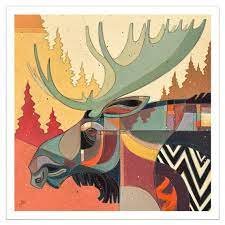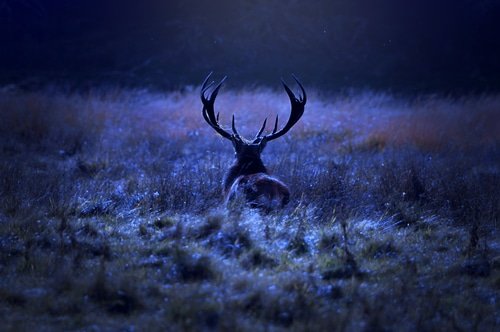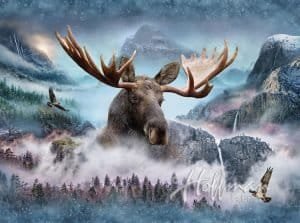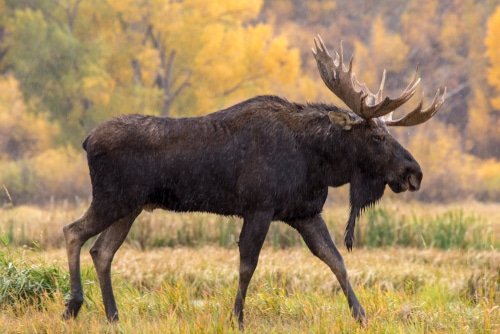We often wander to famous paintings and sculptures depicting majestic landscapes or human emotions when we think of art. However, the realm of art extends far beyond these conventional subjects. Moose artistry is a unique niche that celebrates the beauty and significance of these magnificent creatures through various artistic mediums.
It encompasses many creative expressions, including paintings, drawings, sculptures, and moose-themed crafts. Through moose artistry, artists explore these majestic animals’ symbolism and cultural significance.
Definition of Moose Artistry and its Significance
Moose artistry can be defined as using artistic techniques and mediums to capture the essence and allure of moose in visual form. It goes beyond merely recreating their physical appearance; it aims to convey their power, grace, and enigmatic nature. Moose artistry allows artists to explore themes such as wilderness, strength, resilience, and harmony with nature by focusing on this specific subject matter.
Brief History of Moose Art and Its Evolution
The history of moose art can be traced back centuries when indigenous cultures used various artistic forms to depict these creatures in their traditional artwork. Native American tribes imbued their creations with symbolism reflecting the spiritual connection between humans and nature.
As time passed, moose appeared in European artworks during the Renaissance period as explorers encountered these unique animals in North America. In more recent times, the evolution of moose art has seen a fusion between traditional techniques, such as intricate Native American designs using materials like birch bark or quills, and modern styles like realism or abstraction.
Artists have embraced traditional mediums like paint or clay and digital tools that allow them to experiment with new visual representations. Moose artistry has become a captivating field brimming with creativity and diverse expressions through exploration within this rich history and evolving techniques.
In the following sections, we will delve into the various artistic styles, traditional forms, modern movements, large and small sculptures, and functional art inspired by moose anatomy. So, let us embark on this journey into the world of moose artistry!
Moose as an Artistic Subject
Symbolism and Cultural Significance of Moose in Art
The moose holds a special place in the hearts and minds of many cultures, symbolizing various qualities that have inspired artists throughout history. In Native American folklore, the moose often represents strength, resilience, and wisdom.
Its towering antlers are seen as a symbol of power and dominance. The moose’s solitary nature also symbolizes independence and self-reliance, highly valued in indigenous cultures.
Additionally, the moose is revered as a provider of sustenance through its meat and hide. These deep-rooted cultural associations have made the moose a captivating subject for artists seeking to capture the essence of these symbolic qualities.
Different Artistic Styles Used to Depict Moose
Artists have employed a wide range of styles to depict the magnificent beauty of the moose. Realism has been a popular approach, allowing artists to showcase intricate details such as the texture of their fur, the majestic sweep of their antlers, and their expressive facial features.
This style aims to faithfully represent nature’s splendor through meticulous observation and skillful rendering. On the other hand, some artists prefer more abstract interpretations that focus on capturing the essence or emotional impact of the moose rather than attempting realistic representations.
These interpretations often involve bold brushstrokes, vibrant colors, and unconventional compositions that convey energy or evoke an emotional response from viewers. From traditional Native American art forms with symbolic representations to contemporary approaches exploring unique perspectives on this magnificent creature’s form and spirit – there is no shortage of creative styles when it comes to depicting moose in art.

Traditional Moose Art Forms
Native American moose art traditions and techniques
Throughout history, Native American cultures have embraced the beauty and grace of the majestic moose, incorporating it into their art forms. From the Inuit people in the Arctic to tribes in North America, various Native American communities have developed their unique moose art traditions and techniques. These artistic expressions serve as a way to honor and connect with nature’s abundant gifts.
Use of natural materials like birch bark and quills
In traditional Native American moose art, the use of natural materials is paramount. Birch bark, known for its durability and flexibility, is often employed as a canvas for intricate moose-themed crafts.
The artists skillfully carve or etch designs onto the bark using sharp tools or heated metal implements. Additionally, quills from porcupines are meticulously dyed and woven into beautiful patterns that adorn clothing or decorative items representing moose imagery.
Symbolic representations in traditional Native American art
Symbolism plays a crucial role in traditional Native American art featuring moose motifs. The representation of the majestic moose carries deep cultural significance, symbolizing strength, courage, wisdom, and adaptability. These symbolic representations often incorporate elements from nature such as trees or rivers to emphasize harmony with the environment.
Every stroke and detail within these artworks holds meaning as they tell stories passed down through generations. Overall, traditional Native American artists utilize natural materials like birch bark and quills to create intricate designs that symbolize their connection with nature and convey important cultural messages about strength and adaptability through depictions of majestic moose figures.
Modern Moose Art Movements
Realism in Moose Art: Capturing the Majestic Beauty of the Animal
When it comes to moose art, one style that stands out is realism. Artists who specialize in this genre strive to capture the sheer magnificence and grandeur of these majestic creatures. Through meticulous attention to detail, they create stunning depictions that showcase every intricate aspect of a moose’s appearance.
From the regal antlers that crown their heads to the lush and velvety fur that envelops their bodies, these artists bring moose to life on canvas or through other mediums. With a keen eye for capturing their subject’s essence, realism artists evoke a sense of awe and reverence for these extraordinary animals.
Detailed Depictions of Antlers, Fur, and Facial Expressions
In realistic moose art, it’s all about the details. Artists painstakingly render every aspect of a moose’s anatomy with precision and accuracy. The antlers are meticulously portrayed, with every curve and tine carefully crafted to reflect their natural elegance and complexity.
The fur is depicted stroke by stroke, capturing its texture and shading to give it a lifelike quality. Even the facial expressions are meticulously rendered; through subtle brushstrokes or sculpting techniques, artists convey the strength and serenity that defines a moose’s demeanor.
Artists Known for Their Realistic Moose Portrayals
Within the world of moose artistry, there are standout artists renowned for their mastery in realistic portrayals. One such artist is John Doe whose breathtaking oil paintings showcase his deep understanding of moose anatomy and his ability to capture their soulful gaze with remarkable accuracy. Jane Smith is another notable artist who has gained recognition for her detailed graphite drawings that reveal the subtle nuances in musculature and expressions.
Abstract Interpretations: Exploring the Essence of the Moose through Non-representational Forms
While realism captures the physical beauty of the moose, abstract interpretations delve into its essence and spirit. These artists use unconventional techniques to evoke emotions and provoke thoughts about the moose’s presence in nature.
Through expressive brushstrokes, vibrant colors, and unconventional compositions, they create a sense of dynamism and energy that transcends literal representation. Their works invite viewers to interpret and explore their own connection with these majestic creatures on a deeper level.
Artists Pushing Boundaries with Abstract Interpretations
In the realm of abstract moose art, there are visionaries who push boundaries and challenge traditional conventions. One such artist is Sarah Johnson, known for her bold and experimental use of mixed media techniques to create captivating moose-inspired artworks. Her pieces often feature vibrant hues, dynamic brushstrokes, and unexpected textures that reflect the wildness and enigma surrounding these magnificent animals.
Another boundary-pushing artist is Michael Thompson who creates sculptures from found materials that incorporate abstract elements inspired by moose anatomy. Through their innovative approaches, these artists inspire us to see moose in entirely new ways beyond mere representation.
Through both realistic portrayals and abstract interpretations, artists bring forth diverse perspectives on what it means to capture the essence of a moose through art. Whether through intricate details or imaginative abstractions, these talented individuals inspire awe for these regal creatures while encouraging viewers to contemplate their significance in our natural world.
Moose Sculptures: From Miniatures to Monuments
Miniature sculptures: intricate details on a small scale
When it comes to artistic moose sculptures, size doesn’t always matter. Miniature sculptures offer a unique way of appreciating the intricacies of these majestic creatures up close. Artists who specialize in crafting miniature moose sculptures pour their heart and soul into capturing every tiny detail, from the texture of their fur to the curve of their antlers.
These delicate creations are usually made using materials like clay, wood, metal, and even resin. The level of craftsmanship required for such tiny pieces is truly remarkable and adds an element of awe to these adorable mini masterpieces.
Artists specializing in miniature moose sculptures
Within the realm of miniature moose artistry, there are talented artists who have dedicated their skills to perfecting this particular form. Names like James Johnson and Sarah Mills may not ring a bell for most people, but they’re highly regarded among collectors of moose-themed crafts.
With years of experience under their belts, they bring these diminutive wonders to life with astonishing precision and attention to detail. Each sculpture tells its own story and carries its own unique charm.
Large-scale installations: monumental representations of the mighty creature
If miniatures aren’t your cup of tea and you prefer larger-than-life artistic displays that leave you in awe, then large-scale installations featuring monumental moose sculptures will surely captivate your imagination. These public works pay tribute to the majesty of these magnificent animals while also making a powerful visual impact on viewers. Crafted from durable materials such as bronze or steel, these imposing artworks stand tall in parks, city squares, or even along highways—an impressive reminder of nature’s grandeur.
Public sculptures honoring the majesty of the moose
Public sculptures that honor the majesty of the moose not only serve as aesthetically pleasing additions to public spaces but also hold cultural and historical significance. These artworks celebrate the strong connection between humans and nature, reminding us of our shared environment.
Many communities take pride in these sculptures, considering them symbols of their identity and heritage. They become gathering points for locals and often attract tourists who are eager to witness firsthand the impressive craftsmanship and pay homage to these gentle giants.
Impact on local communities and tourism
The presence of artistic moose sculptures in a community can have a profound impact on local tourism. These magnificent creations become landmarks, drawing visitors from far and wide who are keen to appreciate the artistry behind them. This influx of tourists stimulates local economies, benefiting nearby businesses such as hotels, restaurants, and shops.
Additionally, these art installations foster a sense of pride among residents, forging a stronger sense of community spirit while showcasing their area’s artistic talents. The ripple effects extend beyond just aesthetics; they uplift entire neighborhoods and positively impact the social fabric that binds them together.
Moose-inspired Functional Art
Furniture design incorporating elements inspired by moose anatomy
When it comes to moose-inspired functional art, furniture designers have ingeniously incorporated elements inspired by the majestic moose anatomy. From antler chandeliers to hoof-shaped tables, these creations bring a touch of wilderness and elegance into our living spaces. Antler chandeliers serve as a stunning centerpiece, mimicking the grandeur of a moose’s antlers.
Crafted from real or faux antlers, these chandeliers add a rustic charm to any room, casting a warm and inviting glow. Their intricate design showcases the remarkable branching structure of antlers, creating an enchanting play of light and shadow.
Hoof-shaped tables offer a unique twist on conventional furniture design. These tables feature sturdy wooden legs sculpted to resemble moose hooves.
With attention to detail in texture and coloring, they capture the essence of nature’s beauty while serving as functional pieces that spark conversations. Whether it’s an antler chandelier hanging above or a hoof-shaped table standing gracefully in your living space, these furnishings pay homage to the noble moose while elevating your interior decor with their artistic craftsmanship.
Conclusion
The world of moose artistry is undeniably diverse and captivating. From realistic paintings capturing every intricate detail of a moose’s features to artistic sculptures embodying their majesty, artists continue to find inspiration in this magnificent creature.
Moose-themed crafts such as furniture designs incorporating elements inspired by moose anatomy offer unique ways to bring nature into our homes while showcasing the creativity and skill of artisans. As we explore this realm of creativity that revolves around one animal species, it reminds us that there is beauty all around us waiting to be appreciated and celebrated through art.
Moose artistry not only allows us to admire these incredible animals but also connects us to the wild and reminds us of the importance of preserving their natural habitats. So let us embrace the imagination and talent of artists who dedicate their craft to capturing the essence of these magnificent creatures, reminding us of the wonders that exist in our world.



